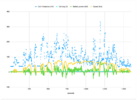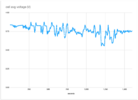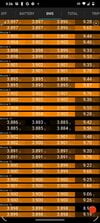Just curious how much cell imbalance people see when they accelerate quickly? My cell imbalance starts out around 2mv to 6mv when leisurely cruising, but jumps pretty high during moments of heavy 'throttle'. Theoretically this doesn't hurt my head, but was wondering how high imbalance people have seen and within what range is "normal". Here's a plot of my imbalance I just made of a couple squeezes of the accelerator....

Welcome to Tesla Motors Club
Discuss Tesla's Model S, Model 3, Model X, Model Y, Cybertruck, Roadster and More.
Register
Install the app
How to install the app on iOS
You can install our site as a web app on your iOS device by utilizing the Add to Home Screen feature in Safari. Please see this thread for more details on this.
Note: This feature may not be available in some browsers.
-
Want to remove ads? Register an account and login to see fewer ads, and become a Supporting Member to remove almost all ads.
You are using an out of date browser. It may not display this or other websites correctly.
You should upgrade or use an alternative browser.
You should upgrade or use an alternative browser.
"Normal" cell imbalance for high load (Scan My Tesla data)
- Thread starter insaneoctane
- Start date
Although, I haven't monitored cell imbalance on my car, the cell imbalance under acceleration is possibly caused by increased resistive voltage drop imbalance in the connections to the cells when heavy current is drawn from the batter, and not in the cells themselves. The resistive imbalance cannot be seen under low/no acceleration because of the lower current drawn.
ElectricIAC
Good-Natured Rascal
How’d you get that?Just curious how much cell imbalance people see when they accelerate quickly? My cell imbalance starts out around 2mv to 6mv when leisurely cruising, but jumps pretty high during moments of heavy 'throttle'. Theoretically this doesn't hurt my head, but was wondering how high imbalance people have seen and within what range is "normal". Here's a plot of my imbalance I just made of a couple squeezes of the accelerator....
View attachment 514007
I don't get how someone thinks this post is funny. If they don't need more explanation wrt the equivalent circuit underlying this electric analysis, go ahead and ask. I'm happy to explain more details.Although, I haven't monitored cell imbalance on my car, the cell imbalance under acceleration is possibly caused by increased resistive voltage drop imbalance in the connections to the cells when heavy current is drawn from the batter, and not in the cells themselves. The resistive imbalance cannot be seen under low/no acceleration because of the lower current drawn.
Just curious how much cell imbalance people see when they accelerate quickly? My cell imbalance starts out around 2mv to 6mv when leisurely cruising, but jumps pretty high during moments of heavy 'throttle'. Theoretically this doesn't hurt my head, but was wondering how high imbalance people have seen and within what range is "normal". Here's a plot of my imbalance I just made of a couple squeezes of the accelerator....
You can't accurately measure the cell imbalance while under a load, as all of the cells aren't measured at the same time; it cycles through them. (I suppose if you could keep the load 100% consistent for a few seconds you might be able to get a good reading.)
Interesting. Reference for this information?You can't accurately measure the cell imbalance while under a load, as all of the cells aren't measured at the same time; it cycles through them. (I suppose if you could keep the load 100% consistent for a few seconds you might be able to get a good reading.)
Thanks for sharing the imbalance info.Search "scan my Tesla" app (here). Requires some hardware too
I knew how SMT works as an app, but how do you make the data to a chart?
Just dropped the data into Excel and pivot table/graph to see it.Thanks for sharing the imbalance info.
I knew how SMT works as an app, but how do you make the data to a chart?
ord3r
Member
Interesting. Reference for this information?
There's some leaked internal documentation floating around, doesn't state this directly, but based on the number of Batman and Robin chips , the number of voltage channels each chip can sense, and the number of cells, MP3Mike's statement sounds reasonable.
brainhouston
Active Member
old thread i know but i like to keep everything in one place 
did some pulls n here's what i see...
Battery temp ~85F
Ignore first few seconds, not sure why it was so high for imbalance (maybe frozen SMT)

Battery temp ~60F

Not sure if this normal or not, no faults in the car n it drives just fine
I always have about 200-300mV imbalance just driving normally n ~700mV at WOT
During idle/charging it goes down <20mV
Also, seems SMT polling frequency is different...
did some pulls n here's what i see...
Battery temp ~85F
Ignore first few seconds, not sure why it was so high for imbalance (maybe frozen SMT)
Battery temp ~60F
Not sure if this normal or not, no faults in the car n it drives just fine
I always have about 200-300mV imbalance just driving normally n ~700mV at WOT
During idle/charging it goes down <20mV
Also, seems SMT polling frequency is different...
Just did this same test (13 MS85 original B pack, 73k miles, not much supercharging)
The goal is to see imbalance. But I'm guessing imbalance data from SMT has no value unless at steady battery demand because
- Sampling delay per post #6. SMT BMS page shows there is at least 6/module x 16 module of voltage sensors on my pack so BMS has 100 sensors to pull to calculate any avg. From my drive cycle, I can see this probably takes a few seconds.
- Cell avg voltage will change by 200mV+ depending on regen and accelerator demand. This is with me driving like grandma haha. Didn't do any pulls (Its the way I drive and I guess side benefit of not wear out HV battery fuse haha). Its like any rechargeable battery, voltage goes down during demand, and goes up when no demand, and goes even higher during charging (regen during drive)
So my data shows the following
- Anytime demand is steady for few seconds. I got < 100mV imbalance. This include
- parked at red light with no AC load and steady cabin heater. 40mV
- 65mph steady highway speed. < 100mV
- climbing big hill (50kw+ demand but steady) for 30s ~100mV
- driving around like grandma but steady change to accelerator and regen 100-300mV
So I think if the goal is to see the imbalance via SMC, probably need situations with steady demand for few seconds. Here is my graphs, anytime you see the green line relatively flat (steady demand from battery), the cell imbalance will be low (50-100) Just before 1250s mark, there was large demand to battery power going up the big hill for probably > 30s. But it was steady so imbalance < 100mV. 2nd chart shows cell avg voltage during same drive cycle so can just super impose onto first graph (couldn't put it on same graph easily without make it unreadable) but you can see it will swing 250mV depending on demand (no pulls, no AC) and regen.


OP's post of 2-3mV imbalance doesn't make sense to me. Perhaps scale is 100x off?
The goal is to see imbalance. But I'm guessing imbalance data from SMT has no value unless at steady battery demand because
- Sampling delay per post #6. SMT BMS page shows there is at least 6/module x 16 module of voltage sensors on my pack so BMS has 100 sensors to pull to calculate any avg. From my drive cycle, I can see this probably takes a few seconds.
- Cell avg voltage will change by 200mV+ depending on regen and accelerator demand. This is with me driving like grandma haha. Didn't do any pulls (Its the way I drive and I guess side benefit of not wear out HV battery fuse haha). Its like any rechargeable battery, voltage goes down during demand, and goes up when no demand, and goes even higher during charging (regen during drive)
So my data shows the following
- Anytime demand is steady for few seconds. I got < 100mV imbalance. This include
- parked at red light with no AC load and steady cabin heater. 40mV
- 65mph steady highway speed. < 100mV
- climbing big hill (50kw+ demand but steady) for 30s ~100mV
- driving around like grandma but steady change to accelerator and regen 100-300mV
So I think if the goal is to see the imbalance via SMC, probably need situations with steady demand for few seconds. Here is my graphs, anytime you see the green line relatively flat (steady demand from battery), the cell imbalance will be low (50-100) Just before 1250s mark, there was large demand to battery power going up the big hill for probably > 30s. But it was steady so imbalance < 100mV. 2nd chart shows cell avg voltage during same drive cycle so can just super impose onto first graph (couldn't put it on same graph easily without make it unreadable) but you can see it will swing 250mV depending on demand (no pulls, no AC) and regen.


OP's post of 2-3mV imbalance doesn't make sense to me. Perhaps scale is 100x off?
Last edited:
Thats normal.Just curious how much cell imbalance people see when they accelerate quickly? My cell imbalance starts out around 2mv to 6mv when leisurely cruising, but jumps pretty high during moments of heavy 'throttle'. Theoretically this doesn't hurt my head, but was wondering how high imbalance people have seen and within what range is "normal". Here's a plot of my imbalance I just made of a couple squeezes of the accelerator....
View attachment 514007
The difference in IR will cause different voltage drops, causing the delta to increase many times over.
Noticed while checking cell imbalance when TMC first startup, numbers would change rapidly while module voltages are pulled by TMC. Reached out to TMC developer, MS/MX android production app cell imbalance is calculated by TMC while pulling module voltages. So there is a huge multi second delay while pulling ~100 voltage readings from all the modules over bluetooth.
Therefore, cell imbalance will have lots of imprecision during high load/charge changes to the the HV battery. So only time it makes sense is when load/charge rates are steady over several seconds. Again, this is for MS/MX in android TMC production release.
For M3, iOS release and MS/MX TMC andriod beta will pull min/max from BMS to calculate imbalance. Thus faster, about every second per developer.
Therefore, cell imbalance will have lots of imprecision during high load/charge changes to the the HV battery. So only time it makes sense is when load/charge rates are steady over several seconds. Again, this is for MS/MX in android TMC production release.
For M3, iOS release and MS/MX TMC andriod beta will pull min/max from BMS to calculate imbalance. Thus faster, about every second per developer.
Somebody's scale seems off, as SMT shows my typical cell imbalance is 6mV.Just did this same test (13 MS85 original B pack, 73k miles, not much supercharging)
The goal is to see imbalance. But I'm guessing imbalance data from SMT has no value unless at steady battery demand because
- Sampling delay per post #6. SMT BMS page shows there is at least 6/module x 16 module of voltage sensors on my pack so BMS has 100 sensors to pull to calculate any avg. From my drive cycle, I can see this probably takes a few seconds.
- Cell avg voltage will change by 200mV+ depending on regen and accelerator demand. This is with me driving like grandma haha. Didn't do any pulls (Its the way I drive and I guess side benefit of not wear out HV battery fuse haha). Its like any rechargeable battery, voltage goes down during demand, and goes up when no demand, and goes even higher during charging (regen during drive)
So my data shows the following
- Anytime demand is steady for few seconds. I got < 100mV imbalance. This include
- parked at red light with no AC load and steady cabin heater. 40mV
- 65mph steady highway speed. < 100mV
- climbing big hill (50kw+ demand but steady) for 30s ~100mV
- driving around like grandma but steady change to accelerator and regen 100-300mV
So I think if the goal is to see the imbalance via SMC, probably need situations with steady demand for few seconds. Here is my graphs, anytime you see the green line relatively flat (steady demand from battery), the cell imbalance will be low (50-100) Just before 1250s mark, there was large demand to battery power going up the big hill for probably > 30s. But it was steady so imbalance < 100mV. 2nd chart shows cell avg voltage during same drive cycle so can just super impose onto first graph (couldn't put it on same graph easily without make it unreadable) but you can see it will swing 250mV depending on demand (no pulls, no AC) and regen.
View attachment 883551View attachment 883550
OP's post of 2-3mV imbalance doesn't make sense to me. Perhaps scale is 100x off?
Or you can see it another way:
In that case, it was 8mV, with the high 3.824 and the low 3.816.
Somebody's scale seems off, as SMT shows my typical cell imbalance is 6mV.
View attachment 884465
Or you can see it another way:View attachment 884466
In that case, it was 8mV, with the high 3.824 and the low 3.816.
Actually, did a bunch of research on this and I think everyone's scale is correct.
I have a 20-30mV imbalance on my pack. See min on module 10 and 12 with car just sitting idle.

But does imbalance # mean health of the pack? Read that couple of threads that suggest not necessarily
- This guy had "perfect imbalance" a few months before pack failed. But didn't publish his numbers. amazing balancing after 145k miles
- This guy had 85mV imbalance and 6mV imbalance a few months later. Car appears to be fully functional the whole time. Vendor - Scan My Tesla, a CANBUS reader for Android
I set my home AC charge SOC at 70% and take mostly short trips. Haven't done any drain to < 10%, charge to 100% (the bleed off some) recals. Tried 90% SOC yesterday and car thermal system runs constantly for hours after charging completed (also posted by others) so stopped doing that. Car was recently completely turn off (HV disconnected) for 2.5 months during drive unit removal and rebuild. I've given up on any recals for now and just going to watch the imbalance going forward.
So not sure what is the "normal" imbalance even with minimal HV pack load. And during high load variations like driving around, cell imbalance data can't be used due to sampling unless steady load for few seconds. See post #14 and sub TMC for SMT
Last edited:
Similar threads
- Replies
- 60
- Views
- 9K
- Replies
- 8
- Views
- 782
- Replies
- 49
- Views
- 4K


